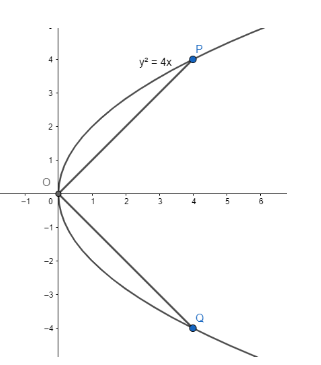
Through the vertex of the parabola\[{{y}^{2}}=4x\]chords\[OP\]and\[OQ\]are drawn at
right angles to one another. The locus of middle point of\[PQ\]is
(a) \[{{y}^{2}}=x+8\]
(b) \[{{y}^{2}}=-2x+8\]
(c) \[{{y}^{2}}=2x-8\]
(d) \[{{y}^{2}}=x-8\]
Answer
223.8k+ views
Hint: To find the locus of the middle point of two points on the parabola, write the points in parametric form and then find the middle point of the points. Use the fact that the product of slope of any two perpendicular lines is\[-1\].
We have the parabola\[{{y}^{2}}=4x\]. We want to find the locus of middle point of two
points on the parabola such that the chords joining two points of the parabola to its vertex are
perpendicular to each other.
We know that the vertex of parabola of the form\[{{y}^{2}}=4ax\]is\[\left( 0,0 \right)\].
Thus, we have\[\left( 0,0 \right)\]as the vertex of the parabola\[{{y}^{2}}=4x\].

To find the locus of middle point of\[PQ\], let’s write the points in parametric form.
We know that any point of the parabola\[{{y}^{2}}=4ax\] is of the form\[\left( a{{t}^{2}},2at \right)\].
Substituting\[a=1\]in the above equation, we have the two points on our parabola as\[P\left(
{{t}_{1}} \right)=\left( t_{1}^{2},2{{t}_{1}} \right)\]and\[Q\left( {{t}_{2}} \right)=\left(
t_{2}^{2},2{{t}_{2}} \right)\].
We know that the equation of any line passing through origin is of the form\[y=mx\].
Let’s assume that the equation of line joining origin and\[P\left( {{t}_{1}} \right)=\left(
t_{1}^{2},2{{t}_{1}} \right)\]is of the form\[y={{m}_{1}}x\].
Substituting the point\[P\left( {{t}_{1}} \right)=\left( t_{1}^{2},2{{t}_{1}} \right)\]in the equation of
line, we have\[2{{t}_{1}}={{m}_{1}}t_{1}^{2}\].
Thus, we have\[{{m}_{1}}=\dfrac{2}{{{t}_{1}}}\]. \[...\left( 1 \right)\]
Let’s assume that the equation of line joining origin and\[Q\left( {{t}_{2}} \right)=\left(
t_{2}^{2},2{{t}_{2}} \right)\]is of the form\[y={{m}_{2}}x\].
Substituting the point\[Q\left( {{t}_{2}} \right)=\left( t_{2}^{2},2{{t}_{2}} \right)\]in the equation of
line, we have\[2{{t}_{2}}={{m}_{2}}t_{2}^{2}\].
Thus, we have\[{{m}_{2}}=\dfrac{2}{{{t}_{2}}}\]. \[...\left( 2 \right)\]
We know that the two chords passing through\[P\]and\[Q\]are perpendicular, so the product of
their slope is\[-1\].
Using equation\[\left( 1 \right)\]and\[\left( 2 \right)\], we have\[{{m}_{1}}{{m}_{2}}=-1\].
\[\begin{align}
& \Rightarrow \dfrac{2}{{{t}_{1}}}\times \dfrac{2}{{{t}_{2}}}=-1 \\
& \Rightarrow {{t}_{1}}{{t}_{2}}=-4 \\
\end{align}\]
Thus, we can write\[{{t}_{1}}\]as\[{{t}_{1}}=\dfrac{-4}{{{t}_{2}}}\]. \[...\left( 3 \right)\]
We know that the middle point of two points of the form\[\left( {{x}_{1}},{{y}_{1}} \right)\]and\[\left(
{{x}_{2}},{{y}_{2}} \right)\]is\[\left( \dfrac{{{x}_{1}}+{{x}_{2}}}{2},\dfrac{{{y}_{1}}+{{y}_{2}}}{2} \right)\].
Substituting\[{{x}_{1}}=t_{1}^{2},{{y}_{1}}=2{{t}_{1}},{{x}_{2}}=t_{2}^{2},{{y}_{2}}=2{{t}_{2}}\]in the
above equation, we have\[\left( \dfrac{t_{1}^{2}+t_{2}^{2}}{2},\dfrac{2{{t}_{1}}+2{{t}_{2}}}{2}
\right)\]as the mid point of the points\[P\left( {{t}_{1}} \right)\]and\[Q\left( {{t}_{2}} \right)\].
Let’s assume\[x=\dfrac{t_{1}^{2}+t_{2}^{2}}{2},y=\dfrac{2{{t}_{1}}+2{{t}_{2}}}{2}\].
Substituting equation\[\left( 3 \right)\]in the above equation, we have\[x=\dfrac{{{\left( \dfrac{-
4}{{{t}_{2}}} \right)}^{2}}+t_{2}^{2}}{2},y=\dfrac{2\left( \dfrac{-4}{{{t}_{2}}} \right)+2{{t}_{2}}}{2}\].
Solving the above equation, we get\[x=\dfrac{{{\left( \dfrac{-4}{{{t}_{2}}}
\right)}^{2}}+t_{2}^{2}}{2}\]and\[y=\dfrac{-4}{{{t}_{2}}}+{{t}_{2}}\].
Squaring the second equation, we get\[{{y}^{2}}={{\left( \dfrac{-4}{{{t}_{2}}} \right)}^{2}}+t_{2}^{2}-
8\].
\[\Rightarrow {{y}^{2}}+8={{\left( \dfrac{-4}{{{t}_{2}}} \right)}^{2}}+t_{2}^{2}\]
Substituting the above equation in\[x=\dfrac{{{\left( \dfrac{-4}{{{t}_{2}}} \right)}^{2}}+t_{2}^{2}}{2}\],
we get\[x=\dfrac{{{\left( \dfrac{-4}{{{t}_{2}}} \right)}^{2}}+t_{2}^{2}}{2}=\dfrac{{{y}^{2}}+8}{2}\].
\[\Rightarrow 2x={{y}^{2}}+8\]
Hence, the correct answer is\[{{y}^{2}}=2x-8\].
Note: It’s necessary to use the fact that the two chords are perpendicular and hence, the product of their slope is\[-1\].
We have the parabola\[{{y}^{2}}=4x\]. We want to find the locus of middle point of two
points on the parabola such that the chords joining two points of the parabola to its vertex are
perpendicular to each other.
We know that the vertex of parabola of the form\[{{y}^{2}}=4ax\]is\[\left( 0,0 \right)\].
Thus, we have\[\left( 0,0 \right)\]as the vertex of the parabola\[{{y}^{2}}=4x\].

To find the locus of middle point of\[PQ\], let’s write the points in parametric form.
We know that any point of the parabola\[{{y}^{2}}=4ax\] is of the form\[\left( a{{t}^{2}},2at \right)\].
Substituting\[a=1\]in the above equation, we have the two points on our parabola as\[P\left(
{{t}_{1}} \right)=\left( t_{1}^{2},2{{t}_{1}} \right)\]and\[Q\left( {{t}_{2}} \right)=\left(
t_{2}^{2},2{{t}_{2}} \right)\].
We know that the equation of any line passing through origin is of the form\[y=mx\].
Let’s assume that the equation of line joining origin and\[P\left( {{t}_{1}} \right)=\left(
t_{1}^{2},2{{t}_{1}} \right)\]is of the form\[y={{m}_{1}}x\].
Substituting the point\[P\left( {{t}_{1}} \right)=\left( t_{1}^{2},2{{t}_{1}} \right)\]in the equation of
line, we have\[2{{t}_{1}}={{m}_{1}}t_{1}^{2}\].
Thus, we have\[{{m}_{1}}=\dfrac{2}{{{t}_{1}}}\]. \[...\left( 1 \right)\]
Let’s assume that the equation of line joining origin and\[Q\left( {{t}_{2}} \right)=\left(
t_{2}^{2},2{{t}_{2}} \right)\]is of the form\[y={{m}_{2}}x\].
Substituting the point\[Q\left( {{t}_{2}} \right)=\left( t_{2}^{2},2{{t}_{2}} \right)\]in the equation of
line, we have\[2{{t}_{2}}={{m}_{2}}t_{2}^{2}\].
Thus, we have\[{{m}_{2}}=\dfrac{2}{{{t}_{2}}}\]. \[...\left( 2 \right)\]
We know that the two chords passing through\[P\]and\[Q\]are perpendicular, so the product of
their slope is\[-1\].
Using equation\[\left( 1 \right)\]and\[\left( 2 \right)\], we have\[{{m}_{1}}{{m}_{2}}=-1\].
\[\begin{align}
& \Rightarrow \dfrac{2}{{{t}_{1}}}\times \dfrac{2}{{{t}_{2}}}=-1 \\
& \Rightarrow {{t}_{1}}{{t}_{2}}=-4 \\
\end{align}\]
Thus, we can write\[{{t}_{1}}\]as\[{{t}_{1}}=\dfrac{-4}{{{t}_{2}}}\]. \[...\left( 3 \right)\]
We know that the middle point of two points of the form\[\left( {{x}_{1}},{{y}_{1}} \right)\]and\[\left(
{{x}_{2}},{{y}_{2}} \right)\]is\[\left( \dfrac{{{x}_{1}}+{{x}_{2}}}{2},\dfrac{{{y}_{1}}+{{y}_{2}}}{2} \right)\].
Substituting\[{{x}_{1}}=t_{1}^{2},{{y}_{1}}=2{{t}_{1}},{{x}_{2}}=t_{2}^{2},{{y}_{2}}=2{{t}_{2}}\]in the
above equation, we have\[\left( \dfrac{t_{1}^{2}+t_{2}^{2}}{2},\dfrac{2{{t}_{1}}+2{{t}_{2}}}{2}
\right)\]as the mid point of the points\[P\left( {{t}_{1}} \right)\]and\[Q\left( {{t}_{2}} \right)\].
Let’s assume\[x=\dfrac{t_{1}^{2}+t_{2}^{2}}{2},y=\dfrac{2{{t}_{1}}+2{{t}_{2}}}{2}\].
Substituting equation\[\left( 3 \right)\]in the above equation, we have\[x=\dfrac{{{\left( \dfrac{-
4}{{{t}_{2}}} \right)}^{2}}+t_{2}^{2}}{2},y=\dfrac{2\left( \dfrac{-4}{{{t}_{2}}} \right)+2{{t}_{2}}}{2}\].
Solving the above equation, we get\[x=\dfrac{{{\left( \dfrac{-4}{{{t}_{2}}}
\right)}^{2}}+t_{2}^{2}}{2}\]and\[y=\dfrac{-4}{{{t}_{2}}}+{{t}_{2}}\].
Squaring the second equation, we get\[{{y}^{2}}={{\left( \dfrac{-4}{{{t}_{2}}} \right)}^{2}}+t_{2}^{2}-
8\].
\[\Rightarrow {{y}^{2}}+8={{\left( \dfrac{-4}{{{t}_{2}}} \right)}^{2}}+t_{2}^{2}\]
Substituting the above equation in\[x=\dfrac{{{\left( \dfrac{-4}{{{t}_{2}}} \right)}^{2}}+t_{2}^{2}}{2}\],
we get\[x=\dfrac{{{\left( \dfrac{-4}{{{t}_{2}}} \right)}^{2}}+t_{2}^{2}}{2}=\dfrac{{{y}^{2}}+8}{2}\].
\[\Rightarrow 2x={{y}^{2}}+8\]
Hence, the correct answer is\[{{y}^{2}}=2x-8\].
Note: It’s necessary to use the fact that the two chords are perpendicular and hence, the product of their slope is\[-1\].
Recently Updated Pages
JEE Isolation, Preparation and Properties of Non-metals Important Concepts and Tips for Exam Preparation

Isoelectronic Definition in Chemistry: Meaning, Examples & Trends

Ionisation Energy and Ionisation Potential Explained

Iodoform Reactions - Important Concepts and Tips for JEE

Introduction to Dimensions: Understanding the Basics

Instantaneous Velocity Explained: Formula, Examples & Graphs

Trending doubts
JEE Main 2026: City Intimation Slip Releasing Today, Application Form Closed, Exam Dates, Syllabus & Eligibility

JEE Main 2026 Application Login: Direct Link, Registration, Form Fill, and Steps

Understanding the Angle of Deviation in a Prism

How to Convert a Galvanometer into an Ammeter or Voltmeter

Ideal and Non-Ideal Solutions Explained for Class 12 Chemistry

Hybridisation in Chemistry – Concept, Types & Applications

Other Pages
JEE Advanced Marks vs Ranks 2025: Understanding Category-wise Qualifying Marks and Previous Year Cut-offs

JEE Advanced 2026 - Exam Date (Released), Syllabus, Registration, Eligibility, Preparation, and More

JEE Advanced 2026 - Exam Date (Released), Syllabus, Registration, Eligibility, Preparation, and More

Understanding Electromagnetic Waves and Their Importance

Understanding Atomic Structure for Beginners

NCERT Solutions for Class 11 Maths Chapter 10 Conic Sections




